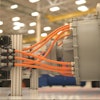“Remaining competitive” takes on many meanings, depending on your location in the world, but here are some thoughts on how American manufacturers can do it better today. By the time you finish reading this column, another entrepreneur will have figured out a way to make it happen for his or her company.
Time-to-market reduction is as critical today as ever. Shorter innovation cycles, the result of new product lifecycle management software and services available to companies both big and small, mean the savvy product companies can take their concept and make it fly in just a fraction of the time spent in the past — and by “past”, I mean compared to about ten years ago.
With the recent, rapid expansion of application-specific integrated circuit (ASIC) capability, much more functionality can be built into a product today and this means the manufacturing community must be even more flexible and responsive, not merely reactive, than ever before.
With the “big data” impact that has resulted from the above scenario, the manufacturer is challenged in many ways, not the least of which is the daunting task of deciphering the important or exceptional from the nominal. A quality ERP or MES system can tell you what you need to know, but the key is the determining factors that make up the inputs to these systems and how their priorities are set.
From my perspective in the motion control world, where customers task us with the control, generation or application of movement on everything from a machine tool to a packaging line, from a chemical processing plant to a printing plant, we see a great variety of needs among OEMs as well as end-users in these various segments. All of them require flexibility and often highly-customized solutions to their manufacturing or processing challenges. Plus, maintaining high productivity on aging equipment is a constant concern for every American company. Do they need to retrofit their existing machine or invest in a new one? Are enhanced robotics and transfer mechanisms or more personnel required on the line? Should the focus be on better asset management or an entirely new business model, when thinking about their factories or processing facilities? Today, as the digital factory emerges in all industries, we find ourselves providing answers to these questions, based upon not only product, but also software, communications, bus protocol and other areas of manufacturing expertise. The answer to a simple question from the past such as which motor horsepower to use is now expanded by the availability of variable frequency drives that can impact the choices made, depending upon the applications involved.
It’s now a popular saying that “data drives utilization.” Using data smartly, however, requires an educated workforce who can take product design and turn it into viable and profitable production for the employer, regardless of the widget, chemistry or package being produced. In a world dictated by product lifecycle management needs, the correlation between design, production planning, output and delivery, plus the monitoring of usage and returns in the field, has never been more important, but also never more manageable, given the new tools available from both product and service providers in the market today.
With IT as the link, today’s digital factory will, as we say, tie the shop floor to the top floor. A word about security: The involvement of your suppliers, especially as it pertains to the cyber security of big data, is a critical factor today. While technology is key, so is the old-fashioned but highly underrated notion of trust. Companies are most productive when they can trust their suppliers, especially those who promote a “defense in depth” approach for cyber security.
That value can often come in unseen ways, such as the access provided to your workforce for prompt and effective answers to questions. Perhaps it’s a 24-hour hotline, perhaps it’s an onboard technical manual in the machine controller with troubleshooting capability on-screen, or perhaps it’s a supplier-provided training webinar that will expand the way your operators and maintenance personnel use their machines. Taking full advantage of these services will improve the productivity of your factory floor. You hear about total cost of ownership (TCO) and this is one of those subtle but very real factors that drives that calculation.
Another key area in remaining competitive is the cost of energy. The more a machine can do with less energy, the more efficient and profitable it becomes. That’s the obvious part. How to get there can take many forms. For example, the simple notion of regenerative energy, a concept in play in the electrical world since Sprague’s regen braking motor in 1886, can be monitored and manipulated by today’s drives, putting power back onto the grid or using it to drive other equipment. By simply implementing “smart” motors, drives and other equipment, manufacturers can improve their productivity and the bottom line — a win-win, to be sure.
Lastly, safety must be paramount, not only as it protects the workforce, but also as it contributes to overall efficiency and the profit picture. Fewer accidents result when there is a reduction in the mean time to repair and equipment is replaced before it malfunctions and hurts someone. This requires implementing both preventive and predictive maintenance protocols at your company. It really does work, every time.
When all of the above are considered and acted upon, American industry can return to higher growth levels, once again.
Arun Jain is Vice President of Siemens Industry, Inc. Motion Control Business.






















